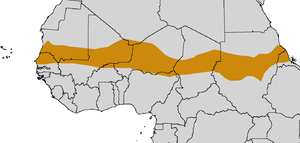2012 Sahel drought
From Wikipedia, the free encyclopedia

The Sahel region – a belt up to 1,000 km wide that spans Africa from the Atlantic Ocean to the Red Sea
In May 2012, United Nations humanitarian chief Valerie Amos warned that more than 18 million people were facing hunger across eight countries in West Africa including the Sahel region.[1] A combination of failed crops, insect plague, high food prices, conflict and drought collectively cause the ensuing famine.[2]
Mauritania and Chad have recorded a loss in crop yield of over 50% when compared to 2011. Food reserves in the areas affected are very low and combine with corn prices soaring by 60-85% compared to averages over the last five years. In Chad alone this food crisis affects some 3.6 million people.[3]
See also
| Wikinews has related news: Imminent danger of famine in the Sahel |
External links
- FAO, the 2012 Sahel Crisis
- Oxfam 2012, Food Crisis in Sahel
- SOS Children 2012, Sahel drought
- Thomson Reuters Alertnet 2012, Coming weeks critical to tackle Sahel hunger – U.N. humanitarian chief
- The Guardians Poverty Matters Blog May 2012, Baaba Maal: people in the Sahel region need food and water now
- ABC News, May 2012, UN: 18 Million in West Africa to Go Hungry in 2012
- CNN, June 2012, A distress call from Africa's Sahel: Millions might starve
References
- ↑ Mendy Diop (May 24, 2012). "UN relief coordinator warns over humanitarian crisis in Africa’s drought-hit Sahel". UN News Centre. Retrieved 21 August 2012.
- ↑ Fominyen, George. "Coming weeks critical to tackle Sahel hunger – U.N. humanitarian chief". Thomson Reuters Foundation. Retrieved 10 June 2012.
- ↑ "Food Crisis in Sahel". Oxfam International. Retrieved 10 June 2012.
This article is issued from Wikipedia. The text is available under the Creative Commons Attribution/Share Alike; additional terms may apply for the media files.